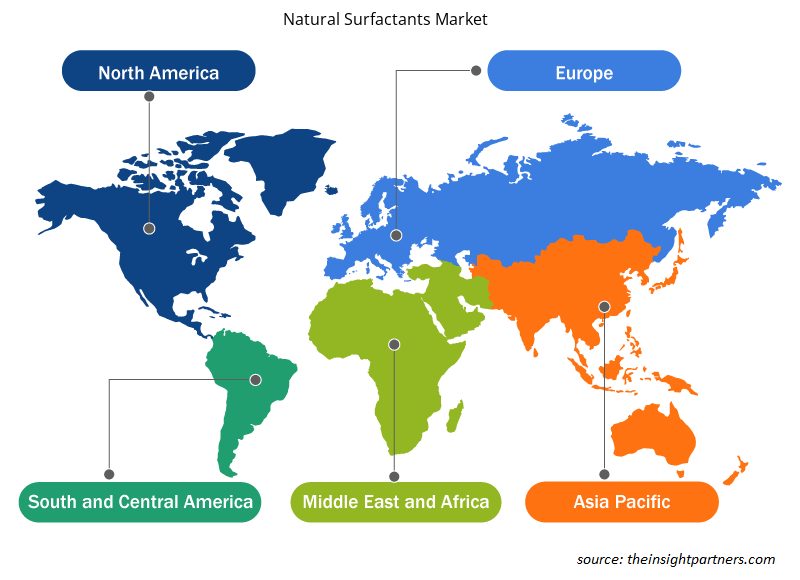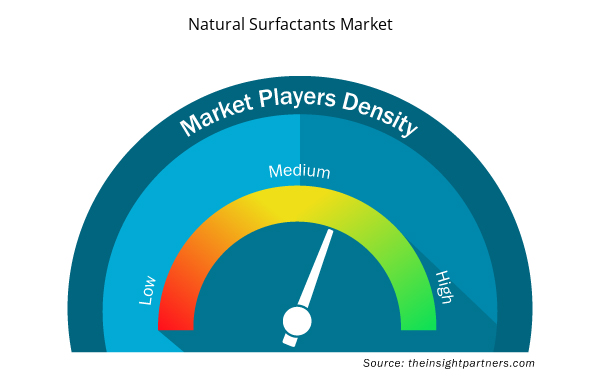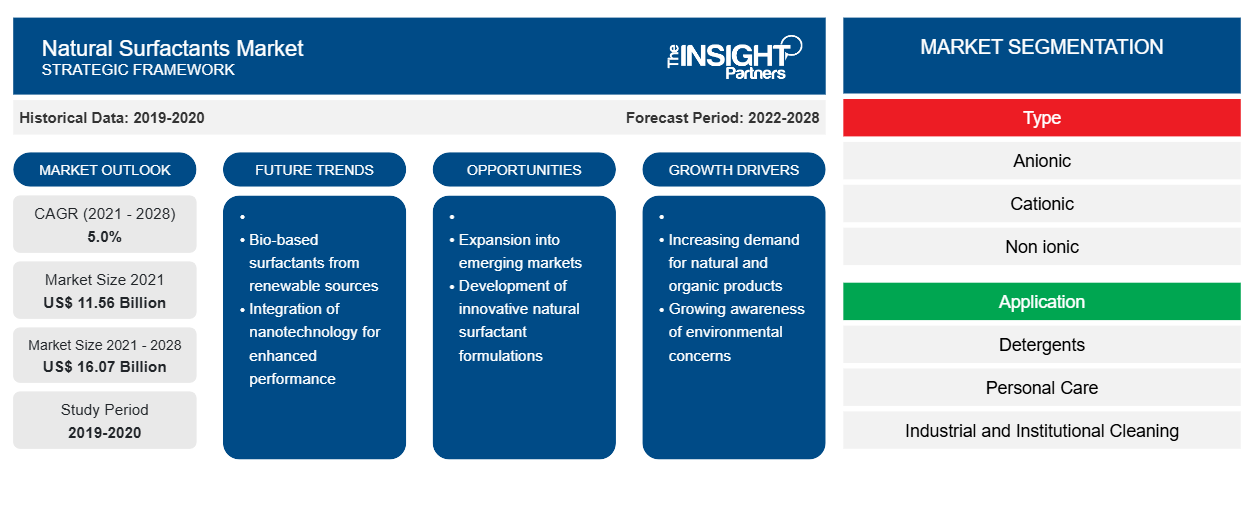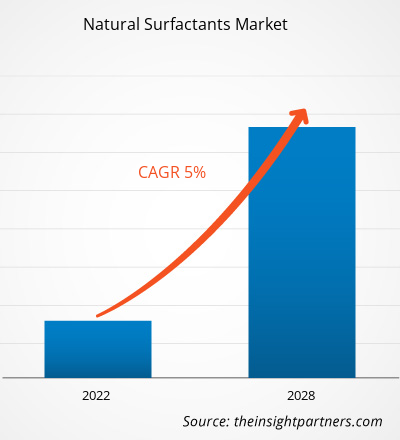[Informe de investigación] Se espera que el mercado de surfactantes naturales crezca de US$ 11.558,34 millones en 2021 a US$ 16.069,28 millones en 2028; se estima que crecerá a una CAGR del 5,0% entre 2022 y 2028.
Los surfactantes naturales se obtienen de diferentes tipos de plantas. Las fuentes más comunes son el coco o la palma, pero también pueden derivarse de otros tipos de verduras y frutas. Además, los surfactantes naturales también pueden producirse a partir de desechos y subproductos industriales. Los surfactantes naturales se biodegradan con mayor facilidad que sus contrapartes sintéticas debido a su origen biológico.
En 2021, Asia Pacífico tuvo la mayor participación en los ingresos del mercado mundial de surfactantes naturales . Los principales factores que impulsan el mercado de surfactantes naturales en Asia Pacífico son la creciente conciencia de los beneficios de los surfactantes naturales y su uso cada vez mayor en diferentes aplicaciones, como detergentes, cosméticos y cuidado personal, limpieza industrial y agricultura. Los surfactantes sintetizados químicamente, al estar basados en petróleo, generalmente no son biodegradables y son tóxicos para el medio ambiente. Los procesos de producción de surfactantes sintéticos y subproductos pueden ser peligrosos para el medio ambiente. Como resultado, existe una creciente conciencia de la necesidad de proteger el medio ambiente. Por lo tanto, el uso de surfactantes naturales está aumentando en la región, lo que está impulsando el crecimiento del mercado de surfactantes naturales en Asia Pacífico.
Personalice este informe según sus necesidades
Obtendrá personalización en cualquier informe, sin cargo, incluidas partes de este informe o análisis a nivel de país, paquete de datos de Excel, así como también grandes ofertas y descuentos para empresas emergentes y universidades.
- Obtenga las principales tendencias clave del mercado de este informe.Esta muestra GRATUITA incluirá análisis de datos, desde tendencias del mercado hasta estimaciones y pronósticos.
Impacto de la pandemia de COVID-19 en el mercado de surfactantes naturales
Antes de la pandemia de COVID-19, el mercado de surfactantes naturales se había visto impulsado principalmente por su creciente uso en diversas industrias, como el cuidado personal, los detergentes, la limpieza industrial e institucional, los productos químicos para yacimientos petrolíferos, los productos químicos agrícolas y otros. Sin embargo, en 2020, varias industrias tuvieron que ralentizar sus operaciones debido a las interrupciones en las cadenas de valor causadas por el cierre de las fronteras nacionales e internacionales. La pandemia de COVID-19 provocó interrupciones en la cadena de suministro de materias primas clave y obstaculizó los procesos de fabricación debido a las restricciones impuestas por las autoridades gubernamentales en numerosos países. La demanda de surfactantes naturales de varias industrias disminuyó debido al cierre de las industrias.
La demanda de productos de higiene personal y cuidado del hogar aumentó debido a la pandemia de COVID-19, lo que ha tenido un impacto positivo en la producción de surfactantes naturales para el hogar y otras aplicaciones. Además, el surfactante natural tiene un papel clave en la lucha contra la pandemia. Los surfactantes naturales comunes se utilizan en jabones y otros productos de limpieza personal, detergentes para ropa y limpiadores de superficies sólidas para desactivar el SARS-CoV-2 y eliminarlo de la piel y otras superficies.
Perspectivas del mercado
Demanda creciente de detergentes para uso doméstico
Con la creciente prevalencia de enfermedades infecciosas, especialmente COVID-19, las personas están tomando mayor conciencia de la limpieza y la higiene. La importancia de la desinfección de manos, la higiene y la limpieza ha aumentado debido a la rápida aparición de enfermedades infecciosas como el norovirus y la gripe. La necesidad de detergentes en aplicaciones domésticas está creciendo debido al mayor uso de detergentes para ropa y productos de limpieza para el hogar.
Los detergentes se utilizan habitualmente para la limpieza porque combinan el agua y el aceite, lo que los hace eficaces contra las manchas de aceite y la grasa. Los profesionales sanitarios están llevando a cabo campañas de concienciación sobre la higiene en varios países en desarrollo para llamar la atención de los clientes y concienciarlos. Como resultado, la demanda de productos de limpieza para el hogar y el cuidado personal por parte de los consumidores está aumentando.
Tipo de información
Según el tipo, el mercado mundial de tensioactivos naturales se segmenta en aniónicos, catiónicos, no iónicos y anfóteros. El segmento aniónico tuvo la mayor participación de mercado de tensioactivos naturales en 2021. Los tensioactivos aniónicos se caracterizan por un grupo polar hidrófilo con carga negativa. Son los tensioactivos más utilizados debido a su mejor poder de limpieza y la gran cantidad de espuma que producen. Estos tensioactivos son los mejores en limpieza, ya que limpian mediante repulsión cargada. Los tensioactivos aniónicos son excelentes para eliminar la suciedad, la arcilla y algunas manchas de grasa. Estos tensioactivos aniónicos se pueden encontrar en champús, geles de ducha, pasta de dientes, etc. El glutamato, el cocoato de potasio, el isetionato y el coco sulfato de sodio son algunos de los ejemplos de tensioactivos aniónicos naturales.
Entre los actores que operan en el mercado global de surfactantes naturales se encuentran BASF SE, Clariant AG, Croda International Plc, Dow Inc., KAO Corporation, Lankem Ltd., Solvay SA, Arkema, Stepan Company y Evonik Industries AG. Los actores que operan en el mercado de surfactantes naturales se centran en proporcionar productos de alta calidad para satisfacer la demanda de los clientes. También se centran en estrategias como inversiones en actividades de investigación y desarrollo y lanzamientos de nuevos productos.
Informe Destacado
- Tendencias progresivas de la industria en el mercado de surfactantes naturales para ayudar a los actores a desarrollar estrategias efectivas a largo plazo
- Estrategias de crecimiento empresarial adoptadas por los mercados desarrollados y en desarrollo
- Análisis cuantitativo del mercado de surfactantes naturales de 2020 a 2028
- Estimación de la demanda mundial de surfactantes naturales
- Análisis de las cinco fuerzas de Porter para ilustrar la eficacia de los compradores y proveedores que operan en la industria
- Avances recientes para comprender el escenario competitivo del mercado
- Tendencias y perspectivas del mercado, así como factores que impulsan y restringen el crecimiento del mercado de surfactantes naturales
- Asistencia en el proceso de toma de decisiones destacando las estrategias de mercado que sustentan el interés comercial, lo que lleva al crecimiento del mercado de surfactantes naturales.
- El tamaño del mercado de surfactantes naturales en varios nodos
- Descripción detallada y segmentación del mercado, así como la dinámica de la industria de los surfactantes naturales.
- Tamaño del mercado de surfactantes naturales en diversas regiones con prometedoras oportunidades de crecimiento
Perspectivas regionales del mercado de surfactantes naturales
Los analistas de Insight Partners explicaron en detalle las tendencias y los factores regionales que influyen en el mercado de surfactantes naturales durante el período de pronóstico. Esta sección también analiza los segmentos y la geografía del mercado de surfactantes naturales en América del Norte, Europa, Asia Pacífico, Oriente Medio y África, y América del Sur y Central.

- Obtenga datos regionales específicos para el mercado de surfactantes naturales
Alcance del informe de mercado de tensioactivos naturales
| Atributo del informe | Detalles |
|---|---|
| Tamaño del mercado en 2021 | US$ 11,56 mil millones |
| Tamaño del mercado en 2028 | US$ 16.07 mil millones |
| CAGR global (2021-2028) | 5.0% |
| Datos históricos | 2019-2020 |
| Período de pronóstico | 2022-2028 |
| Segmentos cubiertos | Por tipo
|
| Regiones y países cubiertos | América del norte
|
| Líderes del mercado y perfiles de empresas clave |
|
Densidad de actores del mercado de surfactantes naturales: comprensión de su impacto en la dinámica empresarial
El mercado de los surfactantes naturales está creciendo rápidamente, impulsado por la creciente demanda de los usuarios finales debido a factores como la evolución de las preferencias de los consumidores, los avances tecnológicos y una mayor conciencia de los beneficios del producto. A medida que aumenta la demanda, las empresas amplían sus ofertas, innovan para satisfacer las necesidades de los consumidores y aprovechan las tendencias emergentes, lo que impulsa aún más el crecimiento del mercado.
La densidad de actores del mercado se refiere a la distribución de las empresas o firmas que operan dentro de un mercado o industria en particular. Indica cuántos competidores (actores del mercado) están presentes en un espacio de mercado determinado en relación con su tamaño o valor total de mercado.
Las principales empresas que operan en el mercado de surfactantes naturales son:
- BASF SE
- Clariant AG
- Croda Internacional Plc
- Compañía: Dow Inc.
- Corporación KAO
Descargo de responsabilidad : Las empresas enumeradas anteriormente no están clasificadas en ningún orden particular.

- Obtenga una descripción general de los principales actores clave del mercado de surfactantes naturales
Mercado mundial de surfactantes naturales
Por tipo
- Aniónico
- Glutamato
- Cacao de potasio
- Isetionato
- Otros
- Catiónico
- Esilato de isoleucinato de brasicilo
- Metosulfato de dialquiléster de amonio
- Cloruro de benzalconio esterquat
- Policuaternio
- CTAC (cloruro de cetrimonio)
- BTAC (cloruro de behentrimonio)
- Otros
- No iónico
- Saponinas
- Glucósidos
- Glicéridos
- Etoxilatos
- Cocamida MEA (CMEA)
- Cocamida DEA (CDEA)
- Otros
- Anfótero
- Betaínas
- Anfoacetatos
- Sultanas
- Óxidos de amina y otros
Por aplicación
- Detergentes
- Cuidado personal
- Limpieza Industrial e Institucional
- Productos químicos para yacimientos petrolíferos
- Productos químicos para la agricultura
- Otros
Perfiles de empresas
- BASF SE
- Clariant AG
- Croda Internacional Plc
- Compañía: Dow Inc.
- Corporación KAO
- Compañía Lankem Ltd.
- Solvay SA
- Arcama
- Compañía Stepan
- Industrias Evonik AG
- Análisis histórico (2 años), año base, pronóstico (7 años) con CAGR
- Análisis PEST y FODA
- Tamaño del mercado Valor/volumen: global, regional, nacional
- Industria y panorama competitivo
- Conjunto de datos de Excel


- Embolization Devices Market
- Cosmetic Bioactive Ingredients Market
- Ceramic Injection Molding Market
- Long Read Sequencing Market
- Virtual Production Market
- Grant Management Software Market
- Quantitative Structure-Activity Relationship (QSAR) Market
- Semiconductor Metrology and Inspection Market
- Diaper Packaging Machine Market
- Investor ESG Software Market

Report Coverage
Revenue forecast, Company Analysis, Industry landscape, Growth factors, and Trends

Segment Covered
This text is related
to segments covered.

Regional Scope
North America, Europe, Asia Pacific, Middle East & Africa, South & Central America

Country Scope
This text is related
to country scope.
Preguntas frecuentes
The global natural surfactants market is primarily driven by increasing demand for detergents in household application and growing requirement for nontoxic and highly biodegradable products.
Asia Pacific is estimated to register the fastest CAGR in the global natural surfactants market over the forecast period. This is mainly attributed to an increasing use of natural surfactants in different application fields and an innovative research on natural surfactants.
The detergents segment held the largest share of the global natural surfactants market in 2021. Natural surfactant’s excellent compatibility and stability is favoring their inclusion in the formulation of laundry detergents.
The anionic segment held the largest share of the global natural surfactants market in 2021. Anionic surfactants are characterized by a negatively charged hydrophilic polar group. Anionic surfactants are highly used in shampoos, shower gels, toothpaste, etc.
In 2021, Asia Pacific held the largest share of the global natural surfactants market. Increasing awareness of the benefits of natural surfactants and their increasing use in different application fields are mainly driving the natural surfactants market in Asia Pacific.
Major players operating in the global natural surfactants market includes, BASF SE, Clariant AG, Croda International Plc, Dow Inc., KAO Corporation, Lankem Ltd., Solvay S.A., Arkema, Stepan Company, and Evonik Industries AG.
The List of Companies - Natural Surfactants Market
- BASF SE
- Clariant AG
- Croda International Plc
- Dow Inc.
- KAO Corporation
- Lankem Ltd.
- Solvay S.A.
- Arkema
- Stepan Company
- Evonik Industries AG
The Insight Partners performs research in 4 major stages: Data Collection & Secondary Research, Primary Research, Data Analysis and Data Triangulation & Final Review.
- Data Collection and Secondary Research:
As a market research and consulting firm operating from a decade, we have published and advised several client across the globe. First step for any study will start with an assessment of currently available data and insights from existing reports. Further, historical and current market information is collected from Investor Presentations, Annual Reports, SEC Filings, etc., and other information related to company’s performance and market positioning are gathered from Paid Databases (Factiva, Hoovers, and Reuters) and various other publications available in public domain.
Several associations trade associates, technical forums, institutes, societies and organization are accessed to gain technical as well as market related insights through their publications such as research papers, blogs and press releases related to the studies are referred to get cues about the market. Further, white papers, journals, magazines, and other news articles published in last 3 years are scrutinized and analyzed to understand the current market trends.
- Primary Research:
The primarily interview analysis comprise of data obtained from industry participants interview and answers to survey questions gathered by in-house primary team.
For primary research, interviews are conducted with industry experts/CEOs/Marketing Managers/VPs/Subject Matter Experts from both demand and supply side to get a 360-degree view of the market. The primary team conducts several interviews based on the complexity of the markets to understand the various market trends and dynamics which makes research more credible and precise.
A typical research interview fulfils the following functions:
- Provides first-hand information on the market size, market trends, growth trends, competitive landscape, and outlook
- Validates and strengthens in-house secondary research findings
- Develops the analysis team’s expertise and market understanding
Primary research involves email interactions and telephone interviews for each market, category, segment, and sub-segment across geographies. The participants who typically take part in such a process include, but are not limited to:
- Industry participants: VPs, business development managers, market intelligence managers and national sales managers
- Outside experts: Valuation experts, research analysts and key opinion leaders specializing in the electronics and semiconductor industry.
Below is the breakup of our primary respondents by company, designation, and region:

Once we receive the confirmation from primary research sources or primary respondents, we finalize the base year market estimation and forecast the data as per the macroeconomic and microeconomic factors assessed during data collection.
- Data Analysis:
Once data is validated through both secondary as well as primary respondents, we finalize the market estimations by hypothesis formulation and factor analysis at regional and country level.
- Macro-Economic Factor Analysis:
We analyse macroeconomic indicators such the gross domestic product (GDP), increase in the demand for goods and services across industries, technological advancement, regional economic growth, governmental policies, the influence of COVID-19, PEST analysis, and other aspects. This analysis aids in setting benchmarks for various nations/regions and approximating market splits. Additionally, the general trend of the aforementioned components aid in determining the market's development possibilities.
- Country Level Data:
Various factors that are especially aligned to the country are taken into account to determine the market size for a certain area and country, including the presence of vendors, such as headquarters and offices, the country's GDP, demand patterns, and industry growth. To comprehend the market dynamics for the nation, a number of growth variables, inhibitors, application areas, and current market trends are researched. The aforementioned elements aid in determining the country's overall market's growth potential.
- Company Profile:
The “Table of Contents” is formulated by listing and analyzing more than 25 - 30 companies operating in the market ecosystem across geographies. However, we profile only 10 companies as a standard practice in our syndicate reports. These 10 companies comprise leading, emerging, and regional players. Nonetheless, our analysis is not restricted to the 10 listed companies, we also analyze other companies present in the market to develop a holistic view and understand the prevailing trends. The “Company Profiles” section in the report covers key facts, business description, products & services, financial information, SWOT analysis, and key developments. The financial information presented is extracted from the annual reports and official documents of the publicly listed companies. Upon collecting the information for the sections of respective companies, we verify them via various primary sources and then compile the data in respective company profiles. The company level information helps us in deriving the base number as well as in forecasting the market size.
- Developing Base Number:
Aggregation of sales statistics (2020-2022) and macro-economic factor, and other secondary and primary research insights are utilized to arrive at base number and related market shares for 2022. The data gaps are identified in this step and relevant market data is analyzed, collected from paid primary interviews or databases. On finalizing the base year market size, forecasts are developed on the basis of macro-economic, industry and market growth factors and company level analysis.
- Data Triangulation and Final Review:
The market findings and base year market size calculations are validated from supply as well as demand side. Demand side validations are based on macro-economic factor analysis and benchmarks for respective regions and countries. In case of supply side validations, revenues of major companies are estimated (in case not available) based on industry benchmark, approximate number of employees, product portfolio, and primary interviews revenues are gathered. Further revenue from target product/service segment is assessed to avoid overshooting of market statistics. In case of heavy deviations between supply and demand side values, all thes steps are repeated to achieve synchronization.
We follow an iterative model, wherein we share our research findings with Subject Matter Experts (SME’s) and Key Opinion Leaders (KOLs) until consensus view of the market is not formulated – this model negates any drastic deviation in the opinions of experts. Only validated and universally acceptable research findings are quoted in our reports.
We have important check points that we use to validate our research findings – which we call – data triangulation, where we validate the information, we generate from secondary sources with primary interviews and then we re-validate with our internal data bases and Subject matter experts. This comprehensive model enables us to deliver high quality, reliable data in shortest possible time.


 Obtenga una muestra gratuita de este informe
Obtenga una muestra gratuita de este informe